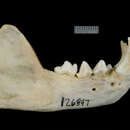ar
الأسماء في صفحات التنقل


Perception Channels: tactile ; chemical
The tayra is not endangered in most of its range; in some parts of South America it is the most common carnivore due to its ability to live near humans in disturbed habitats. However, in Mexico, human spread of agriculture, loss of tropical habitat, and hunting have greatly reduced populations. The Mexican sub-species, E. b. senex, is now considered vulnerable by the IUCN (Emmons, 1990; Nowak, 1999).
US Federal List: no special status
CITES: appendix iii
IUCN Red List of Threatened Species: least concern
Because of the close proximity of the tayra's habitat to that of humans, specifically human farmers, this species has been known to cause some damage to neighboring plantations. Eira barbara occasionally eats poultry and raids corn and sugar fields, but damage is usually minimal (Nowak, 1999).
It has been found that Eira barbara can be tamed, and is often used by humans as pets. The Tayra was once used by the indigenous people of the area to control rodents (Nowak, 1999).
The tayra is omnivorous. It shows a preference for small mammals, the spiny rat in particular, but it will eat whatever is available. Mammals are the most abundant part of the tayra's diet but it also eats significant amounts of fruit, invertebrates and reptiles, in that order. It has also been shown that the tayra occasionally eats honeycomb when it is available (Bisbal, 1986; McNab, 1995).
Animal Foods: mammals; reptiles; insects; terrestrial non-insect arthropods; mollusks
Plant Foods: fruit
Primary Diet: omnivore
The tayra, Eira barbara, can be found in the neotropical forests of Central and South America. It ranges from Mexico south to Bolivia and northern Argentina and also on the island of Trinidad (Mares et al., 1989; Reid, 1997).
Biogeographic Regions: neotropical (Native )
Tayra are found in tropical deciduous and evergreen forests, secondary growth, and plantations. The elevation of the tayra's habitat ranges from the lowlands to about 2000-2400m. Because the tayra is both terrestrial and arboreal, it has been found to live in hollow trees, burrows built by other animals, and occasionally in tall grass (Reid, 1997; Nowak, 1999).
Range elevation: 0 to 2400 m.
Habitat Regions: temperate ; tropical ; terrestrial
Terrestrial Biomes: forest ; rainforest ; scrub forest
Other Habitat Features: agricultural
Average lifespan
Status: captivity: 18.0 years.
The tayra is a weasel about the size of a medium sized dog, with a long, bushy tail and long neck ending in a robust head. Its head and body range from 60 to 70 cm in length and its tail length is 35 to 45 cm. Tayras have large hind feet varying in length from 80 to 90 mm and ears about 35 to 40 mm long. Color varies with geographic range, but in general the tayra has a dark brown body with a slightly paler head. Usually it has a white, diamond shaped patch on its throat. Tayras have long claws and pronounced canines. Their dental pattern is 3/3, 1/1, 3/4, 1/1 =34.
Range mass: 3 to 6 kg.
Range length: 60 to 70 cm.
Other Physical Features: endothermic ; heterothermic ; bilateral symmetry
Sexual Dimorphism: sexes alike
Average basal metabolic rate: 6.811 W.
Little is known about the tayra's reproduction. It is thought, however, that gestation lasts for about 63-70 days with a litter size of 2-3 babies per season, each weighing about 74-92 grams. Newborns open their eyes at about 35-58 days and they nurse for 2-3 months. Some believe that the estrous cycle of Eira barbara is seasonal, with births occuring in March and July. Others believe that the tayra is polyestrous and a non-seasonal breeder, experiencing an estrous cycle of around 17 days with a 2-3 day receptivity about three times a year (Nowak, 1999).
Breeding interval: Tayras probably breed once per year at most.
Range number of offspring: 2 to 3.
Range gestation period: 63 to 70 days.
Range weaning age: 2 to 3 months.
Key Reproductive Features: iteroparous ; seasonal breeding ; year-round breeding ; gonochoric/gonochoristic/dioecious (sexes separate); sexual ; viviparous
Average birth mass: 83 g.
Average number of offspring: 2.
Average age at sexual or reproductive maturity (male)
Sex: male: 183 days.
Average age at sexual or reproductive maturity (female)
Sex: female: 700 days.